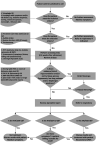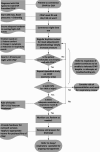Management of Sleep-Disordered Breathing in a Spinal Cord Injury Rehabilitation Center: Model of Care Adaptation and Implementation
- PMID: 38433738
- PMCID: PMC10906372
- DOI: 10.46292/sci23-00049
Management of Sleep-Disordered Breathing in a Spinal Cord Injury Rehabilitation Center: Model of Care Adaptation and Implementation
Abstract
Background: Obstructive sleep apnea (OSA) is highly prevalent and poorly managed in spinal cord injury (SCI). Alternative management models are urgently needed to improve access to care. We previously described the unique models of three SCI rehabilitation centers that independently manage uncomplicated OSA.
Objectives: The primary objective was to adapt and implement a similar rehabilitation-led model of managing OSA in an SCI rehabilitation center in Australia. Secondary objectives were to identify the local barriers to implementation and develop and deliver tailored interventions to address them.
Methods: A clinical advisory group comprised of rehabilitation clinicians, external respiratory clinicians, and researchers adapted and developed the care model. A theory-informed needs analysis was performed to identify local barriers to implementation. Tailored behavior change interventions were developed to address the barriers and prepare the center for implementation.
Results: Pathways for ambulatory assessments and treatments were developed, which included referral for specialist respiratory management of complicated cases. Roles were allocated to the team of rehabilitation doctors, physiotherapists, and nurses. The team initially lacked sufficient knowledge, skills, and confidence to deliver the OSA care model. To address this, comprehensive education and training were provided. Diagnostic and treatment equipment were acquired. The OSA care model was implemented in July 2022.
Conclusion: This is the first time a rehabilitation-led model of managing OSA has been implemented in an SCI rehabilitation center in Australia. We describe a theory-informed method of adapting the model of care, assessing the barriers, and delivering interventions to overcome them. Results of the mixed-methods evaluation will be reported separately.
Keywords: implementation science; rehabilitation; sleep apnea syndromes; spinal cord injuries.
© 2024 American Spinal Injury Association.
Conflict of interest statement
Conflicts of Interest M.G., D.B., and C.L.C. have been involved in research studies that have received equipment and/or funding support from ResMed and Philips Respironics. The other authors declare no conflicts of interest.
Figures


References
-
- Berlowitz DJ, Spong J, Gordon I, Howard ME, Brown DJ. Relationships between objective sleep indices and symptoms in a community sample of people with tetraplegia. Arch Phys Med Rehabil. 2012;93(7):1246–1252. - PubMed
-
- Graco M, McDonald L, Green SE, Jackson ML, Berlowitz DJ. Prevalence of sleep-disordered breathing in people with tetraplegia—a systematic review and meta-analysis. Spinal Cord. 2021;59(5):1–11. - PubMed
-
- Graco M, Ruehland W, Schembri R, et al. Prevalence of central sleep apnoea in people with tetraplegic spinal cord injury: A retrospective analysis of research and clinical data. Sleep. 2023 - PubMed
MeSH terms
LinkOut - more resources
Full Text Sources
Medical
